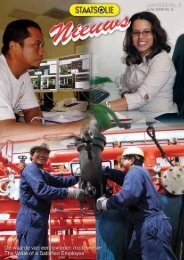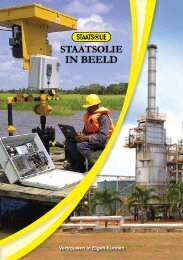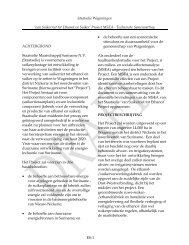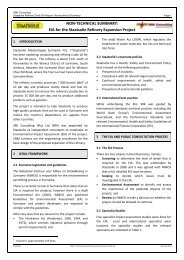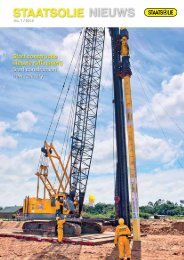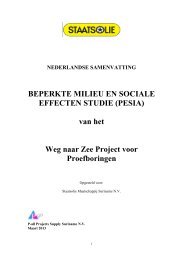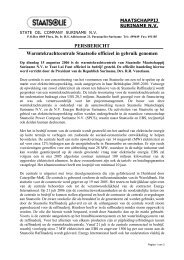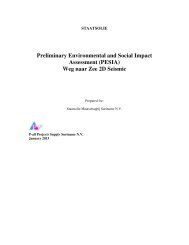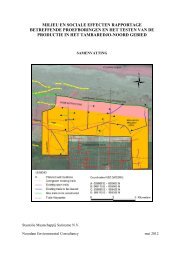concept EIA-rapport - Staatsolie
concept EIA-rapport - Staatsolie
concept EIA-rapport - Staatsolie
You also want an ePaper? Increase the reach of your titles
YUMPU automatically turns print PDFs into web optimized ePapers that Google loves.
SRK Consulting: Project No: 439414 <strong>Staatsolie</strong> Pipeline <strong>EIA</strong> – Draft <strong>EIA</strong> Report Page 38<br />
Very locally isolated spots of Red Mangrove (Rhizophora mangle/racemosa) and/or Brantimaka<br />
shrub (Machaerium lunatum) occur along the river, but vegetation is scarce due to development of<br />
jetties, harbours, industrial and trade facilities and houses.<br />
The natural wildlife of the study area has either disappeared or is significantly reduced in numbers<br />
due to the loss of habitat, hunting and capturing. Remaining wildlife will be concentrated in the<br />
vacant and vegetated parts of the study area. Only species that are commonly associated with<br />
human presence have been encountered:<br />
• Mammals: opossums, bats, monkeys, edentates, carnivores and rodents;<br />
• Birds: herons, black vultures, hawks, parrots and a variety of water and singing birds;<br />
• Reptiles and amphibians: snakes, lizards, caimans, turtles, frogs and toads; and<br />
• Fish: several swamp fish species.<br />
A species list presented by Hardy BBT (1991) for Het Vertrouwen, some 2 km south of the <strong>Staatsolie</strong><br />
refinery, indicates that no vulnerable, rare or endangered species occur in the area.<br />
4.1.6.2 Aquatic ecology<br />
The construction of the Afobaka Dam in the Suriname River had a large impact on the water quality<br />
and fish fauna downstream and upstream of the dam (Mol et al and Panday-Verheuvel in SRK,<br />
2008). The lower Suriname River is a moderately to highly disturbed ecosystem that has been<br />
adversely affected by anthropogenic activities. The study area is located in the lower part of the<br />
freshwater reach of the river (where salinity isbelow 1‰), while the river becomes mesohaline (with<br />
salinity levels of 1-20‰) in the downstream sections (upper estuary).<br />
Fish sampling conducted for the Suriname River Dredging Project (SRDP) found 14 species of fish,<br />
dominated by snook (Centropomus sp), koebi (Plagioscion auratus) and kwasimama (Hypopthalmus<br />
edentatus), in the freshwater reach. The upper estuary of the river (in the vicinity of Paramaribo)<br />
yielded a have higher diversity (25 species), probably as result of the varying water conditions<br />
created by the convergence of the estuarine and freshwater reaches of the river. Phytoplankton<br />
diversity does not correlate with fish diversity and was found to be highest in the freshwater reach of<br />
the river (SRK, 2008). The sampling results are summarised in Table 4-9.<br />
Table 4-9: SRDP results of aquatic sampling in the Suriname River<br />
Upper Estuary Freshwater Reach<br />
Distance from river mouth (i.e. 15 m lowtide<br />
depth contour)<br />
40 – 55 km 55 – 90 km*<br />
Water salinity Mesohaline (1-20‰) Freshwater (




